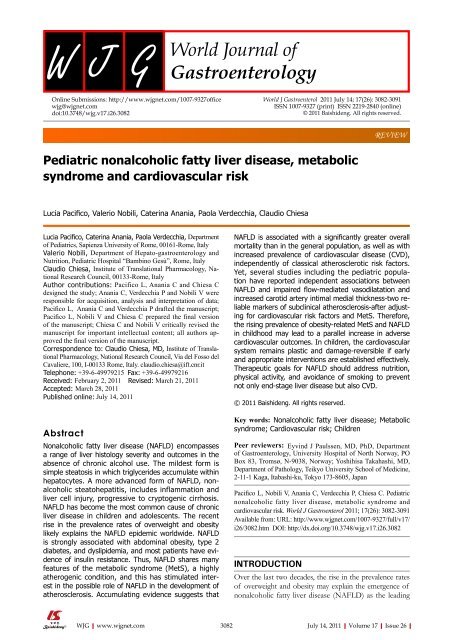26 - World Journal of Gastroenterology
26 - World Journal of Gastroenterology
26 - World Journal of Gastroenterology
Create successful ePaper yourself
Turn your PDF publications into a flip-book with our unique Google optimized e-Paper software.
Online Submissions: http://www.wjgnet.com/1007-9327<strong>of</strong>fice<br />
wjg@wjgnet.com<br />
doi:10.3748/wjg.v17.i<strong>26</strong>.3082<br />
Pediatric nonalcoholic fatty liver disease, metabolic<br />
syndrome and cardiovascular risk<br />
Lucia Pacifico, Valerio Nobili, Caterina Anania, Paola Verdecchia, Claudio Chiesa<br />
Lucia Pacifico, Caterina Anania, Paola Verdecchia, Department<br />
<strong>of</strong> Pediatrics, Sapienza University <strong>of</strong> Rome, 00161-Rome, Italy<br />
Valerio Nobili, Department <strong>of</strong> Hepato-gastroenterology and<br />
Nutrition, Pediatric Hospital “Bambino Gesù”, Rome, Italy<br />
Claudio Chiesa, Institute <strong>of</strong> Translational Pharmacology, National<br />
Research Council, 00133-Rome, Italy<br />
Author contributions: Pacifico L, Anania C and Chiesa C<br />
designed the study; Anania C, Verdecchia P and Nobili V were<br />
responsible for acquisition, analysis and interpretation <strong>of</strong> data;<br />
Pacifico L, Anania C and Verdecchia P drafted the manuscript;<br />
Pacifico L, Nobili V and Chiesa C prepared the final version<br />
<strong>of</strong> the manuscript; Chiesa C and Nobili V critically revised the<br />
manuscript for important intellectual content; all authors approved<br />
the final version <strong>of</strong> the manuscript.<br />
Correspondence to: Claudio Chiesa, MD, Institute <strong>of</strong> Translational<br />
Pharmacology, National Research Council, Via del Fosso del<br />
Cavaliere, 100, I-00133 Rome, Italy. claudio.chiesa@ift.cnr.it<br />
Telephone: +39-6-49979215 Fax: +39-6-49979216<br />
Received: February 2, 2011 Revised: March 21, 2011<br />
Accepted: March 28, 2011<br />
Published online: July 14, 2011<br />
Abstract<br />
Nonalcoholic fatty liver disease (NAFLD) encompasses<br />
a range <strong>of</strong> liver histology severity and outcomes in the<br />
absence <strong>of</strong> chronic alcohol use. The mildest form is<br />
simple steatosis in which triglycerides accumulate within<br />
hepatocytes. A more advanced form <strong>of</strong> NAFLD, nonalcoholic<br />
steatohepatitis, includes inflammation and<br />
liver cell injury, progressive to cryptogenic cirrhosis.<br />
NAFLD has become the most common cause <strong>of</strong> chronic<br />
liver disease in children and adolescents. The recent<br />
rise in the prevalence rates <strong>of</strong> overweight and obesity<br />
likely explains the NAFLD epidemic worldwide. NAFLD<br />
is strongly associated with abdominal obesity, type 2<br />
diabetes, and dyslipidemia, and most patients have evidence<br />
<strong>of</strong> insulin resistance. Thus, NAFLD shares many<br />
features <strong>of</strong> the metabolic syndrome (MetS), a highly<br />
atherogenic condition, and this has stimulated interest<br />
in the possible role <strong>of</strong> NAFLD in the development <strong>of</strong><br />
atherosclerosis. Accumulating evidence suggests that<br />
WJG|www.wjgnet.com<br />
3082<br />
<strong>World</strong> J Gastroenterol 2011 July 14; 17(<strong>26</strong>): 3082-3091<br />
ISSN 1007-9327 (print) ISSN 2219-2840 (online)<br />
© 2011 Baishideng. All rights reserved.<br />
REVIEW<br />
NAFLD is associated with a significantly greater overall<br />
mortality than in the general population, as well as with<br />
increased prevalence <strong>of</strong> cardiovascular disease (CVD),<br />
independently <strong>of</strong> classical atherosclerotic risk factors.<br />
Yet, several studies including the pediatric population<br />
have reported independent associations between<br />
NAFLD and impaired flow-mediated vasodilatation and<br />
increased carotid artery intimal medial thickness-two reliable<br />
markers <strong>of</strong> subclinical atherosclerosis-after adjusting<br />
for cardiovascular risk factors and MetS. Therefore,<br />
the rising prevalence <strong>of</strong> obesity-related MetS and NAFLD<br />
in childhood may lead to a parallel increase in adverse<br />
cardiovascular outcomes. In children, the cardiovascular<br />
system remains plastic and damage-reversible if early<br />
and appropriate interventions are established effectively.<br />
Therapeutic goals for NAFLD should address nutrition,<br />
physical activity, and avoidance <strong>of</strong> smoking to prevent<br />
not only end-stage liver disease but also CVD.<br />
© 2011 Baishideng. All rights reserved.<br />
Key words: Nonalcoholic fatty liver disease; Metabolic<br />
syndrome; Cardiovascular risk; Children<br />
Peer reviewers: Eyvind J Paulssen, MD, PhD, Department<br />
<strong>of</strong> <strong>Gastroenterology</strong>, University Hospital <strong>of</strong> North Norway, PO<br />
Box 83, Tromsø, N-9038, Norway; Yoshihisa Takahashi, MD,<br />
Department <strong>of</strong> Pathology, Teikyo University School <strong>of</strong> Medicine,<br />
2-11-1 Kaga, Itabashi-ku, Tokyo 173-8605, Japan<br />
Pacifico L, Nobili V, Anania C, Verdecchia P, Chiesa C. Pediatric<br />
nonalcoholic fatty liver disease, metabolic syndrome and<br />
cardiovascular risk. <strong>World</strong> J Gastroenterol 2011; 17(<strong>26</strong>): 3082-3091<br />
Available from: URL: http://www.wjgnet.com/1007-9327/full/v17/<br />
i<strong>26</strong>/3082.htm DOI: http://dx.doi.org/10.3748/wjg.v17.i<strong>26</strong>.3082<br />
INTRODUCTION<br />
Over the last two decades, the rise in the prevalence rates<br />
<strong>of</strong> overweight and obesity may explain the emergence <strong>of</strong><br />
nonalcoholic fatty liver disease (NAFLD) as the leading<br />
July 14, 2011|Volume 17|Issue <strong>26</strong>|

















